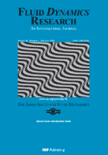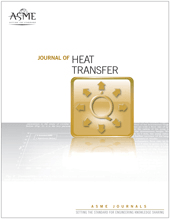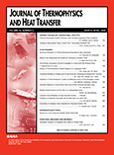
International Journal of Fluid Mechanics Research
Scope & Guideline
Bridging Theory and Practice in Fluid Mechanics
Introduction
Aims and Scopes
- Fluid Dynamics:
The journal emphasizes studies in fluid dynamics, including laminar and turbulent flows, vortex dynamics, and the interaction of fluids with surfaces. - Computational Fluid Dynamics (CFD):
A core area of focus is the application of computational methods to simulate fluid flow and heat transfer, examining phenomena across various engineering and scientific applications. - Thermal and Heat Transfer:
Research on heat transfer mechanisms in fluids, including natural convection, forced convection, and phase change processes, is a significant aspect of the journal. - Fluid-Structure Interaction:
The journal explores the interactions between fluids and solid structures, including the effects of fluid forces on structural integrity and performance. - Innovative Applications:
The scope includes innovative applications of fluid mechanics in engineering fields such as aerospace, automotive, and renewable energy, showcasing advancements in technology and design. - Experimental and Theoretical Studies:
The journal publishes both experimental and theoretical studies, promoting a comprehensive understanding of fluid mechanics phenomena through various approaches.
Trending and Emerging
- Machine Learning Applications:
The integration of machine learning techniques for predicting fluid behavior and optimizing fluid systems is a rapidly growing area, showcasing the potential for artificial intelligence to enhance fluid mechanics research. - Bio-inspired Fluid Dynamics:
Research inspired by biological systems and processes is trending, particularly in the design of aerodynamic structures and fluid flow optimization, reflecting a broader interest in sustainability and innovative engineering solutions. - Complex Fluid Behavior:
Studies focusing on the behavior of complex fluids, such as non-Newtonian fluids and nano-fluids, are gaining traction, highlighting the need to understand advanced materials in various applications. - Thermal Management Systems:
There is an increasing focus on thermal management in engineering applications, particularly in the context of energy efficiency and heat exchanger design, driven by demands for sustainable practices. - Fluid Dynamics in Renewable Energy:
Research at the intersection of fluid dynamics and renewable energy technologies, such as wind and hydro energy, is emerging as a critical area of study, reflecting global efforts towards sustainable energy solutions.
Declining or Waning
- Classical Fluid Mechanics:
Research focused solely on classical fluid mechanics principles, without integration into modern applications or advanced computational techniques, has seen a decline, as researchers seek more innovative and practical applications. - Hydrodynamic Studies in Simple Geometries:
Papers exploring hydrodynamic phenomena in overly simplistic or idealized geometries are less common, as the community increasingly favors studies that reflect real-world complexities. - Basic Turbulence Models:
The use of basic turbulence models without enhancements or modifications has decreased, with a trend towards more sophisticated models that better capture the complexities of turbulent flows. - Low-Reynolds Number Flows:
Research on low-Reynolds number flows, while still relevant, appears to be less frequent, possibly due to a shift in focus toward more practical and high-Reynolds number applications in engineering. - Single-Phase Flow Studies:
The focus on single-phase flow studies has waned in favor of multi-phase flow investigations, reflecting an increased interest in the complexities of realistic fluid systems.
Similar Journals

Journal of Thermal Science
Elevating research standards in thermal science since 1992.Journal of Thermal Science is a prestigious academic publication dedicated to the field of thermal science and its applications. Published by SPRINGER, this journal has been at the forefront of knowledge dissemination since its inception in 1992 and continues to provide a platform for researchers and professionals to share their innovative findings through high-quality peer-reviewed articles. With its ISSN 1003-2169 and E-ISSN 1993-033X, the journal covers a diverse array of topics related to thermal processes, materials, and engineering, significantly contributing to advancements in Condensed Matter Physics. In the latest rankings, it holds a commendable Q2 category in the 2023 quartiles, further highlighting its relevance with a Scopus ranking of #183/434 in its field, placing it in the top 57th percentile. While currently not offering open access, the journal strives to bridge the gap between theory and practice, making substantial impacts on both academia and industry. Its continued exploration of cutting-edge research ensures that it remains a key resource for students and professionals looking to expand their knowledge and foster innovation in thermal sciences.

Journal of Applied Mechanics and Technical Physics
Fostering Dialogue in the Heart of Technical PhysicsJournal of Applied Mechanics and Technical Physics is a distinguished publication that serves as a vital resource for researchers and professionals in the realms of mechanical engineering, mechanics of materials, and condensed matter physics. Published by MAIK NAUKA/INTERPERIODICA/SPRINGER, this journal has been committed to disseminating high-quality research since its inception in 1965. With a noted presence in the academic community, it holds a respectable Q3 ranking in multiple categories as of 2023, indicating its relevance and contribution to the field. Although it does not currently offer open access, the journal provides valuable insights and advancements through its rigorous peer-review process. Covering a broad spectrum of topics in applied mechanics and technical physics, it aims to foster innovation and dialogue among scientists, engineers, and scholars alike. Located in the United States, the journal continues to make significant strides in bridging the gap between theoretical research and practical applications, making it an essential read for anyone engaged in these dynamic fields.

Heat Transfer
Pioneering new frontiers in thermal management technologies.Heat Transfer, published by WILEY, is a leading open-access journal dedicated to advancing the field of heat transfer science, encompassing innovative research and application across various domains. With an ISSN of 2688-4534 and an E-ISSN of 2688-4542, the journal aims to provide a platform for researchers to disseminate their findings from 2020 to 2024, focusing on condensed matter physics and fluid dynamics. Ranked in the Q2 category for both Condensed Matter Physics and Fluid Flow and Transfer Processes, it showcases articles that contribute significantly to the understanding and utilization of heat transfer mechanisms. Located in the United States at 111 River St, Hoboken, NJ 07030, the journal appeals to a diverse audience, including academic researchers, professionals in engineering, and students seeking to deepen their knowledge in thermal sciences. With a strong emphasis on accessibility, Heat Transfer promotes the exchange of ideas and experimental techniques, ultimately driving innovation and collaboration in the advancement of thermal management technologies.

FLUID DYNAMICS RESEARCH
Exploring Interdisciplinary Insights in Fluid FlowFLUID DYNAMICS RESEARCH, published by IOP Publishing Ltd, is a pivotal journal dedicated to advancing the understanding of fluid dynamics through interdisciplinary research that spans several domains including mechanical engineering and physics. With an ISSN of 0169-5983 and E-ISSN 1873-7005, this journal provides a vital platform for researchers aiming to disseminate new findings and theoretical advancements in fluid flow and transfer processes. As of 2023, FLUID DYNAMICS RESEARCH holds a commendable position within the academic community, ranked Q3 in fluid flow and transfer processes, mechanical engineering, and miscellaneous physics and astronomy categories. The journal showcases a diverse array of articles that not only inspire collaboration among professionals and students but also ensure that theoretical and experimental studies are accessible for further development in the field. Operating from the United Kingdom, the journal offers a unique opportunity for scholars worldwide to contribute to the vibrant community dedicated to understanding the complexities of fluid dynamics, even as it anticipates converging its years of research from 1986 to 2024.

International Journal of Heat and Technology
Bridging Theory and Practice in Heat EngineeringThe International Journal of Heat and Technology is a premier academic publication dedicated to the dissemination of innovative research in the fields of thermal engineering, fluid mechanics, and condensed matter physics. Published by the INT INFORMATION & ENGINEERING TECHNOLOGY ASSOCIATION and based in Italy, this journal has been a significant resource for researchers and professionals since its inception in 1983, with a commitment to advancing knowledge until 2024. With an impact factor that reflects its relevance, the journal encompasses diverse topics within its scope, bridging gaps between theoretical research and practical applications. Although currently not open access, the journal provides valuable insights into the nuances of heat transfer, flow dynamics, and material properties, making it a critical reference for academia and industry alike. The journal's Scopus rankings position it within the competitive landscape of chemical and mechanical engineering, highlighting its contribution to advancing these fields. We invite scholars, professionals, and students to engage with the rich content provided within its pages, to foster a deeper understanding of heat and technology in our rapidly evolving world.

JOURNAL OF HEAT TRANSFER-TRANSACTIONS OF THE ASME
Advancing Knowledge in Heat Transfer Excellence.JOURNAL OF HEAT TRANSFER-TRANSACTIONS OF THE ASME, with ISSN 0022-1481 and E-ISSN 1528-8943, is a leading publication in the field of heat transfer, mechanical engineering, and related disciplines, published by the renowned American Society of Mechanical Engineers (ASME). This esteemed journal, which has been in circulation since 1945, provides a platform for novel research findings and reviews that the mechanical engineering community can rely upon, contributing significantly to the advancement of knowledge in heat transfer processes. The journal is recognized for maintaining a strong impact in several categories, attaining Q2 quartile rankings in Condensed Matter Physics, Mechanical Engineering, and Mechanics of Materials, reflecting its influential role in shaping scientific dialogues. With a commendable Scopus ranking, including a percentile of 63rd in Mechanical Engineering, it attracts submissions from leading researchers and industry professionals alike. Although access options are currently undergoing changes, the commitment to disseminating cutting-edge research remains steadfast. Gathering insights from historical and contemporary studies, the JOURNAL OF HEAT TRANSFER stands as a vital resource for those aiming to innovate in heat transfer technologies and methodologies.

JOURNAL OF THERMOPHYSICS AND HEAT TRANSFER
Unlocking the Secrets of Thermal DynamicsJOURNAL OF THERMOPHYSICS AND HEAT TRANSFER, published by the American Institute of Aeronautics and Astronautics, serves as a vital platform for the dissemination of cutting-edge research in the fields of thermophysics and heat transfer. With an ISSN of 0887-8722 and an E-ISSN of 1533-6808, this journal has been pivotal in enhancing our understanding of heat transfer mechanisms since its inception in 1987, continuing through 2024. It occupies a noteworthy position in various academic categories, boasting Q2 rankings in both Fluid Flow and Transfer Processes and Mechanical Engineering, reflecting its significant contribution to the engineering and physical sciences community. Although it currently does not offer Open Access options, the journal’s repository of rigorous peer-reviewed articles remains accessible to researchers, professionals, and students eager to expand their knowledge and apply innovative findings in aerospace, condensed matter physics, and planetary sciences. Emphasizing both theoretical and experimental approaches, the JOURNAL OF THERMOPHYSICS AND HEAT TRANSFER remains an indispensable resource for advancing the frontiers of engineering and applied sciences.

ASME Journal of Heat and Mass Transfer
Pioneering Insights in Thermal EngineeringASME Journal of Heat and Mass Transfer, published by the renowned American Society of Mechanical Engineers (ASME), is a pivotal journal in the fields of mechanical engineering and materials science. With its ISSN 2832-8450 and E-ISSN 2832-8469, this journal aims to disseminate high-quality research focused on the principles and applications of heat transfer and mass transfer phenomena. Despite its recent launch, having converged from 2023 to 2024, it has quickly established a significant presence in the academic community, holding respectable rankings within the Scopus database across various categories—including a 66th percentile rank in Mechanical Engineering. The journal endeavors to foster innovation and collaborative research that advance the frontiers of knowledge in thermal sciences, making it an essential resource for researchers, practitioners, and students keen on exploring the challenges and developments in heat and mass transfer technologies. The journal also embraces an open-access model, ensuring that leading research reaches a broader audience and contributes to global knowledge sharing.

JOURNAL OF ENHANCED HEAT TRANSFER
Transforming Heat Transfer Knowledge into Practical ApplicationsThe JOURNAL OF ENHANCED HEAT TRANSFER, published by BEGELL HOUSE INC, is a prominent resource for researchers and professionals in the fields of mechanical engineering, fluid flow and transfer processes, and condensed matter physics. With a history spanning from 1993 to 2024, this journal offers a platform for disseminating cutting-edge research and innovations that enhance our understanding of heat transfer phenomena. Although it operates under a traditional subscription model, its impressive standing is underscored by its Scopus rankings—positioned within the 59th percentile for Mechanical Engineering and 58th percentile for Fluid Flow and Transfer Processes. Additionally, it holds Q2 and Q3 categorizations in relevant fields, reflecting its importance in advancing knowledge and applications in heat transfer technology. This journal effectively bridges the gap between theoretical insights and practical solutions, making it an indispensable tool for academics, industrial practitioners, and students eager to explore advancements in thermal management and efficiency.

Flow
Elevating scholarly discourse in aerospace and biomedical fields.Flow is a premier open access journal published by Cambridge University Press, dedicated to advancing research in the fields of Aerospace Engineering, Biomedical Engineering, and Fluid Flow and Transfer Processes. Launched in 2021, Flow has rapidly gained recognition and has achieved a prestigious Q1 ranking in its categories for 2023, underscoring its influential role in disseminating high-quality research. With an emerging impact factor and a strong commitment to accessibility, the journal provides a crucial platform for researchers, professionals, and students to share innovative findings and foster collaboration across disciplines. Flow is headquartered in the United Kingdom and is part of Cambridge University's effort to promote scholarly communication that transcends traditional barriers. Whether you are looking to submit your work or explore cutting-edge studies in your field, Flow offers a dynamic and rigorous environment for intellectual exchange.